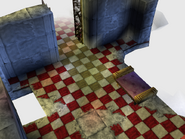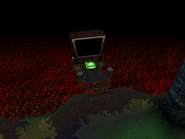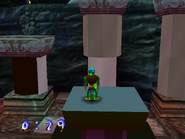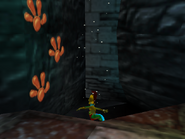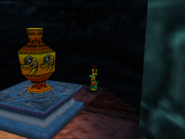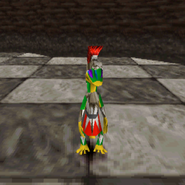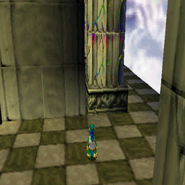
|
I could use some help.
The strategy section of the article is incomplete. Try finishing off the section by adding your own walkthrough/guide how it could be done.
|
Mythology Network is the 7th level/channel of Gex 3: Deep Cover Gecko. The theme is mainly centered around myths and legends from Greece and Rome within the 9th and 5th centuries BC. Here Gex dresses in a toga with a leafy crown, but he can also use certain pedestals to change into HercuGex (a play on Greek hero Hercules), enabling him to break and push certain columns. Gex has to be very careful as the whole level is set over empty space as if it were located on Mount Olympus (so falling is a danger).
The N64 version of the game, however, has Gex traversing through an alternate, grounded version of the level as a gladiator/spartan. Like the PS1 version, he can still turn into HercuGex.
Setting and inspiration[]
The Mythology Network is one of the few stages with the most contrast between platforms. While the PlayStation setting is comprised of Greek structures featuring what appear to be waterfalls emanating from them and hedged by pillars and golden gates, all of this above cloud level (references to buildings like the Parthenon and also to the mythical Mount Olympus), the Nintendo 64 setting is a volcanic cavern surrounded by lava (perhaps a reference to the Minoan eruption in the island of Santorini, speculated by some to have influenced the legend of Atlantis). These differences extend not just to the missions themselves, but also to the gameplay elements, with breakable pillars going from having an ethereal glow emanating from its cracks to lava and the shield of the Trojan Skeletons goes from being more intrinsic to a plain golden. The game actually acknowledges this in the level titles, the PS1 version being called Unsolved Mythstories (a reference to the long-running Unsolved Mysteries series) and the N64 version Et Tu Gecko? (a reference to the murder of Roman emperor Julius Caesar), as if they were different programs within the same channel. Gex's outfit is also completely different, he wears the tunic of the god Hermes in the first but wears Spartan armor in the second.
The Golden Apples that Gex is tasked with collecting (actually eating) in the second mission of the PS1 version are a reference to the myth of the Golden Apple of Discord. In this legend, the chaotic goddess known as Eris tossed the fruit with a dedication that was simply labeled "To the fairest" amidst a divine feast taking place to celebrate the wedding of the hero Peleus and the nymph Thetis, in vengeance for not being invited. Several of the other goddesses present (namely Hera, Athena, and Aphrodite) considered their own selves to be "the fairest" and became embroiled in a superfluous competition that eventually ignited the Trojan War. Another, more notable myth that the Golden Apples appeared in was that of Atalanta. In this legend, the female hunter was initially uninterested in marriage, but eventually agreed to marry anyone who beat her in a footrace, and she outran many of her potential suitors. That luck changed when one day, Hippomenes went to challenge her. He sought help from Aphrodite, who gave him three golden apples, which were used to lure Atalanta off track, allowing Hippomenes to win the race and become her husband. Being tasked with breaking the arms off several statues in the previous mission is likely a reference to the Venus de Milo, one of the most famous Greek sculptures to survive into modern times, which is widely known for this trait. Although other elements are distinctly Greek in origin, the final PSX mission appears to be a reference to the Irish legend of a pot of gold lying at the end of a rainbow. In this version, the Greek alphabet is referenced in the golden gates, which feature the letters "A" for alpha and "Ω" for omega (the dichotomy of these two letters is otherwise used as symbolic of beginning/end in Christianity).
Despite placing emphasis on mythology in its name, none of the versions actually feature deities like Tut TV does with Anubis (as the Priest enemy). Instead, the closest thing to them is the recurrent use of glowing pedestals to turn Gex into a powerful demigod form named HercuGex (that references Hercules) for a limited time. However, most of the enemies are reinterpretations of mythological creatures, including the harpy, ogre and cyclops. The Trojan Skeletons are based on a similar enemy that appeared in the 1963 film Jason and the Argonauts. References to pop culture take place in the gag panels of the N64 version, referencing The Road to Ruin and James Bond's A View to a Kill (used in a pun about Greek hero Achilles). On the other hand, while the Sparta-Cap's most obvious inspiration is the warriors of Greece, in particular Sparta (along with its name being a reference to mythical character Spartacus), there is some (perhaps unintentional) resemblance to Looney Tunes character Marvin the Martian (himself based on the Roman god Mars, which was in turn based on the Greek deity Ares) due to its bodytype and outfit.
Missions and strategy[]
PS1[]
Break the Arms off Five Statues[]
Collect Three Golden Apples[]
Find the TV at the End of the Rainbow[]
N64[]
Break 5 Urns[]
Survive the Ogre's Cave[]
Lick You Way to the Top[]
Gallery[]
Areas[]
PS1[]
N64[]
Early Beta Screenshot[]
Prototype[]
Items[]
Miscellaneous[]
Music[]
NOTE: These songs don't work on Internet Explorer
PS1[]
- Intro
- Main
- HercuGEX
N64[]
Trivia[]
- In the December 30, 1998 PlayStation prototype the N64 version of this level and other levels can be accessed via debug menu.
- In the N64 version of the level, Gex must use his tongue to swing across pits via floating orbs. The level is the only time this ability is seen.
- The mission find the tv on the end of a rainbow mission might be a reference to Asgard from Norse mythology
- This area, like the Egyptian area of Lake Flaccid, contains a "Road to Ruins" joke sign.
- The placeholder name for the level was called 'Myth TV'
| Levels in Gex 3: Deep Cover Gecko | |||
|---|---|---|---|
| Gex Cave (hub) | |||
| Mission Control | Holiday Broadcasting | Mystery TV | ||
| Lake Flaccid | Tut TV | Army Channel | Western Station | The Buccaneer Program | ||
| Slappy Valley | Mythology Network | Fairytales TV | Anime Channel | ||
| Funky Town | Gangster TV | Superhero Show | ||
| Boss levels | WWGex Wrestling | Lizard of Oz | Channel Z | ||
| Bonus Levels | Marsupial Madness | Gextreme Sports | War and Pieces | True Grits | What a Crock! | ||
| Secret Levels | Dial "A" for Arson / Peg Leg Polka | Braveheartless / Temple of Gloom | The Abyssmal | Cheesy Rider | ||
| Unsused Levels | Fish Frequency | Gtown1 | Fvilla1 | Jaws1 | Pirate88 | Proto55 | ||




